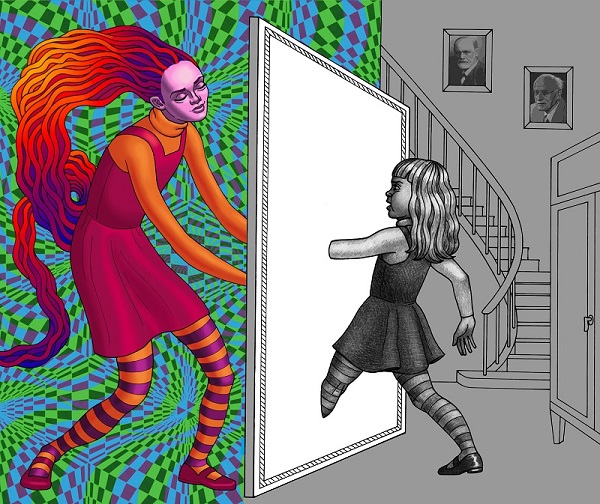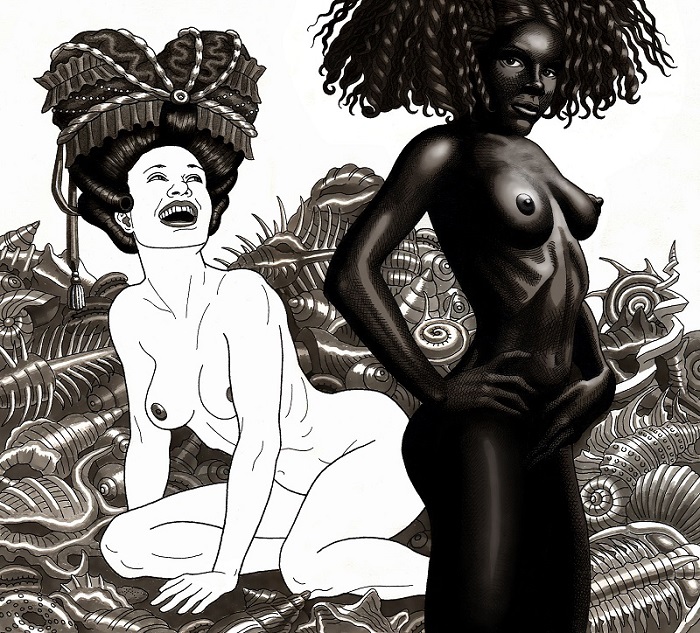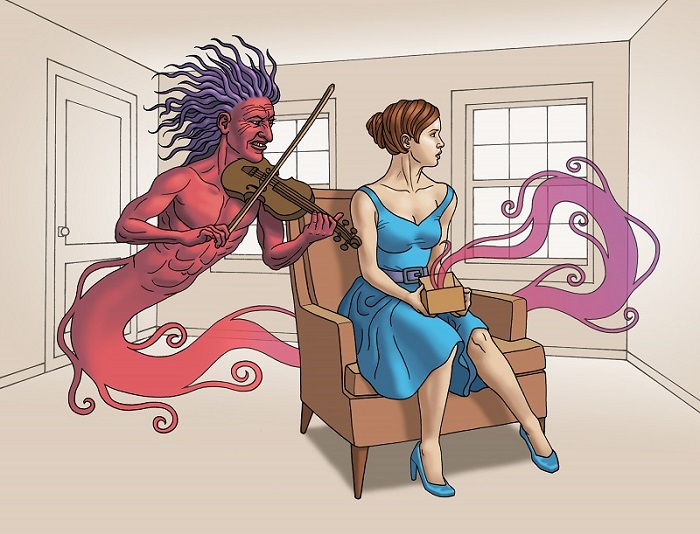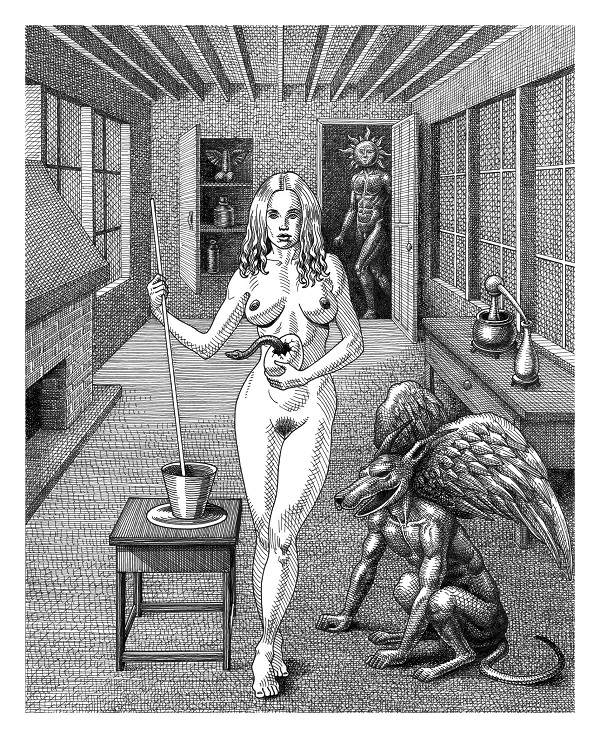David Herrle interviews David Aronson, visual artist
A painting called Looking Glass was my first exposure to David Aronson’s splendid work, and it hooked me immediately. His intense, diverse, irreverent, grotesque, erotic and often wacky art shares the heft and energy of, say, Ernst, Dorothea Tanning, Felicien Rops, Leonor Fini, Leonora Carrington, Schiele, Otto Dix, Francis Bacon, Mucha and (as Aronson himself specifies) Remedios Varo. Stylish/spiritual/tonal comparisons also include Aubrey Beardsley, Peter Chung, fetish-artist Michael Manning, Escher, John Tenniel, Daniel Clowes, Charles Burns, Martin Ander, maybe even a little Terry Gilliam. However, Aronson’s stuff is fundamentally Aronsonian, and behind what he shows there is much to say. (See more of his art here and visit his official site here.)
 Looking Glass
Looking Glass
HERRLE: In Catching the Big Fish David Lynch insists that “the more the artist is suffering, the less creative he is going to be,” but he admits that time and freedom from distractions are needed for art to thrive. Inverting this, Man Ray blames artists’ suffering on the inability to escape “all social constraint,” and funambulist/magician Philippe Petit says that lack of control of the creative process “equals human death.” What do you think?
ARONSON: I don’t really adhere to any one theory of what stimulates creativity or what is necessary to be an artist. I can see, and agree with, the point of view of all three artists you cited. Artists, like people in general, are quite diverse. Everyone has their own reasons for making art and process for doing so. I think creativity is useful for everyone, no matter what form it takes. Using one’s creativity allows a connection between personal energy and universal energy – the energy that created all and lies within all of creation.
Man Ray was a Surrealist and escaping social constraint was part of [the Surrealists’] manifesto. This is something that I strive for as well. It leads to more interesting, unique and powerful art. I also strive to escape the constraints of my conscious mind. Allowing images to arise spontaneously from the subconscious is something else I have in common with the Surrealists.
David Lynch doesn’t see the value of suffering, but I have personally found that periods of suffering, throughout the course of my life, have triggered great outpourings of art and creativity. My work is often cathartic, so that makes sense for me, but not necessarily everyone. If you see a “lack of creativity” as meaning that one feels that their life is out of their control, then I could see that as a form of “human death,” a death of the soul and of one’s will.
HERRLE: On your website’s biography page you are referred to as an “ascetic hedonist,” an oxymoronic/paradoxical term that accords with your apparent humor and tendency to present, to use your bio’s words, “unusual juxtapositions.” What are your thoughts on the ascetic and the hedonic – and on artistic visual/thematic mélange?
ARONSON: At different times in my life I have lived in an ascetic manner and in a hedonistic manner. Eventually, I learned to let those two polarities to co-exist. The reconciliation of conflicting opposites is one of the main themes of my work, both artistically and in the healing work that I do. (I am a certified hypnotherapist, Integrated Energy Therapy master, and professional astrologer and tarot reader.) In alchemy, the stage where opposing forces are joined is known as the alchemical wedding. Hence the name of my site and of my artistic identity as well. I have a tattoo that I designed covering my right upper arm depicting the alchemical wedding. On a more mundane level, I find that unusual juxtapositions in my art, presented in a way that implies a narrative, are more interesting and stimulate people’s imaginations and pull them into the world of the image, rather than just looking at the surface. I’m a big fan of visual mélange for the reasons I just stated. Combining images that have never been combined before can lead to powerful, thought-provoking and enigmatic art.
HERRLE: The female body (particularly the nude one) still reigns as the primary symbol/locus of sensual beauty and the persistent idolatry in Western aesthetics since the waning of the ephebophilic Greeks and andromaniacal Michelangelo. However, PC erotophobes rage against “objectification” – though, as Camille Paglia says, all art objectifies. As someone who obviously delights in the female form, tell us your thoughts on erotic beauty, female portrayal and such. Isn’t this all power rather than detriment?
ARONSON: Yes, it’s true that I love the female body, but I actually love drawing all bodies: male, female, young, old, beautiful and deformed. The human body is almost always at the center of my work. I don’t do landscapes, because they always look to me like a backdrop waiting for some people to come along and do something. The body is sensual in a way that combines the physical and the spiritual. Nudity does not equal pornography. Nude women do not equal sexism or misogyny. I tend to avoid these kinds of political arguments, because people become very entrenched in their points of view, and a true dialogue is rare. I do believe that artists should have the right to portray whatever they want in their art, and people also have the right to refrain from looking at it or exhibiting it. Images are the language of the subconscious, and all of the debates and histrionics about art that have been going on for centuries seem to point to the power of images and the desire for people to control that power.
Then there is also the undercurrent of puritanism which I feel still pervades this country, creating a lack of comfort with sexuality, physicality and the celebration of the body. Another reason I avoid these debates is because I find them a bit ridiculous. Is a picture of a gun more acceptable than a picture of a nude woman? Both are a part of life. When you start dictating what is or isn’t acceptable as a subject for art, then you are hiding from part of life. An extreme example of this is found in Islam and Orthodox Judaism, where art is not allowed to portray the physical world in a realistic manner. I am an art teacher and in one of my children’s classes, a Muslim woman told me that her daughter was only allowed to portray geometric forms. I told her that I couldn’t teach her daughter how to paint or draw if she was not allowed to examine the world around her. Drawing and painting create a kind of communion with the world and if you can’t see the beauty of creation, then I feel sorry for you, but don’t try to tell me what to draw.
HERRLE: Defiant against shameful bush inhibition or erasure, I think full – even unkempt – pubic hair is female genitalia’s best bedding: the wild tufts of Schiele or Delvaux, Courbet’s Origin of the World. Your depictions of females feature both the bushy and the bald, but do you have a preference?
ARONSON: I’ve always love drawing (and looking at) hair, but hair can obscure the beautiful folds and forms of the female genitalia, so I guess I have no strong preference one way or the other.
HERRLE: Many of your splendid illustrations are comic book-/cartoon-like. Have you any favorite comics books, comic artists/writers, cartoonists?
ARONSON: Comic Books were my first love and my first inspiration. I collected them when I was a kid and had thousands. I sold them all when I was 13, but their influence on my work was already permanently in place. As a child, my favorite artists were Neal Adams, Bernie Wrightson, Jack Kirby, Mike Ploog, John Buscema, Joe Kubert, Basil Wolverton, Gil Kane, and many, many others. When I was 13, I discovered Heavy Metal magazine and underground comics. Then I was in love with Moebius, Robert Crumb, Richard Corben, Gilbert Shelton, Victor Moscoso, Robert Williams, S. Clay Wilson, Caza, Nicole Claveloux, and – again – many, many more. The explosion of indie/alternative comics in the 1990s brought me Charles Burns, Peter Bagge, Daniel Clowes, the Hernandez Brothers, Chris Ware, Dave Cooper, and of course, many, many others. I also fell in love with [Neil Gaiman’s] The Sandman, The Invisibles and just about everything Vertigo ever put out. If I sat down and thought about it, I could come up with a list of hundreds of names. I still follow comics, both indie and mainstream. I do find some of them very readable but I accumulate them mainly for the artwork.
HERRLE: In a recent Rolling Stone interview with Jan Wenner, U2’s Bono said, “American is an idea, and it’s a great idea. We want you, it, to succeed, which is why we become fucking obnoxious and shoot our mouths off about it.” This jibes with your “Letter to America” poem, from which this excerpt comes:
I’m so fucking angry at you, America!
You could be the brightest star
of this civilization,
a shining example for all to follow,
but you fumble and drop the ball
and end up with a mouth full of astroturf
time and time again…
…But I also love you, America,
because you have your sights set on
the highest mountain top.
You want to build a ladder to heaven.
You’re a dizzy-eyed, spirit-intoxicated prophet,
willing to die to free the enslaved and the oppressed,
and ready to set yourself on fire
for what is right and true and just!
Right on. Though bratty ungratefulness is foolish, constructive vigilance is crucial. Tell us more about your complex regard for the U.S. Can this nation still live up to being “essentially the greatest poem,” as Walt Whitman considered it?
ARONSON: Wow. Well, that’s a big can of worms, considering who’s in the White House. I wrote that poem during the second Bush administration, and my feelings are still the same. I see the horrible things done by the government and the power elite, but then I see the passion for justice and just plain goodness in ordinary people. Being a Sagittarius, I have a natural optimism that I fall back on as a default. To be honest, I have been ignoring politics as much as possible since last November. I guess I agree with Bono. I want people to live up to the ideals of the founding fathers, but there is so much greed and indifference, that becoming the visionary idea of America seems impossible at times. I’m hoping that Trump is the nadir and that we have nowhere to go from here but up. And I also hope people learn from this ridiculous farce of an administration and make wiser choices in the future.
HERRLE: In “I’m Not a Self-Hating Jew; I’m Just a Jew Who Hates Other Jews” you blast both collectivism’s subsuming nature and mass reformism’s dehumanizing tendency, recalling your parents immersion in The Schecter Reconstructionists. In their wish “to overturn everything and create a brave new world,” you say that they neglected “the law of nature” (the lesson of A Clockwork Orange). You prefer to “take people on an individual basis,” discounting ancestry’s overrated gravity, which I find redemptive. Tell us about your aversion to tribalism, skepticism against utopia and abstention from the Abrahamic “chosen.”
ARONSON: I have never been a follower. I tried my best to fit in, but it never worked. I tried and tried and as time went on, I realized that it would never happen, and that was very freeing. I could finally be myself. I have been a member of a group here and there as an adult, but I’m still on the sidelines, never becoming a devotee or true believer. I recently had my eyes opened by a book called The Invention of the Jewish People. Its premise is that the religion of Judaism, rather than the Jews themselves, was what spread throughout Europe and Northern Africa during the Diaspora. Therefore, Jews are not a unified ethnic group. I’ve always suspected this, even as a child, but being a good member of the tribe is the guilt they use to hold on to you.
I also recently discovered the Khazar empire or Khazaria. This was an empire that existed in between Turkey and Kazakhstan. In the 9th century the entire population converted from their pagan religion to Judaism for political reasons. When the empire was conquered, the people moved into Eastern Europe, and then to America at the turn of the last century. Most American Jews are descended from the Khazars and actually have no genetic connection with the Jews of the Bible. Once again, this was incredibly freeing for me. It meant that I could renounce Judaism the way an Irishman could denounce Catholicism. Being Jewish was not “in my blood.” Hooray! Don’t get me wrong. If you’re a member of a religion and it helps you to be a better person, I’m behind you 100%. But my life experiences (as well as historical knowledge) have completely turned me off to organized religion.
HERRLE: Your affecting Holocaust Series includes the plight of the Native Americans, which is something I separate, along with the Atlantic slave trade, from what I consider the only Holocaust. I side with philosopher Andre Neher’s belief in its essential incomparability. Jew’s existence was the Nazis’ (non-political/non-religious/non-colonial) extermination reason. To your Why Us? piece the answer is “Because you are.” Do pogromic urges (other than Islamist judenhass) simmer around the globe? Am I wrong to isolate Auschwitz et al from other odious eras?
ARONSON: I see your point of view about the Holocaust and far be it from me to tell you or anyone how to think about it. I don’t want to minimize anyone’s pain. There have been many, many large-scale atrocities throughout human history and all of them make me want to cry. I did the Holocaust series for selfish reasons. I was trying to get in touch with and purge personal feelings of persecution and victimization that came from the twisted way that being a Jew was presented to me as a child. I never dreamed that so many people would be moved by it. I wish I had put more time into the series. Some of the images are weak or hurried.
As far as anti-Semitism around the world, I think it will always be there. Like all racism, a lot of it has gone underground. As primates, we’re hard-wired to think “my tribe good, your tribe bad,” but only when we’re using our reptile and/or mammal brains rather than our human brain (I’m referring to the three-brain model. You can look it up if interested.) The human part of the brain, the neo-cortex, is the newest and smallest part of the brain which explains a lot about human behavior. I highly recommend the book The Naked Ape by Desmond Morris. This book gave me a profound understanding of human nature, good and bad. The human need to always have a scapegoat I call “the Sneetch syndrome,” after the story by Dr. Seuss. Ultimately, I think it’s going to take a huge leap in human evolution to finally be free of racism and see ourselves as earthlings before anything else.
HERRLE: There’s a brutal sense of mortality in your work, and you refer to history as a “nightmare.” Japanese poet Issa says that we walk on hell’s flower-covered roof, but G.K. Chesterton warns us not to mistake the siege on the citadel as the citadel itself. Is pessimism reasonable? Despite atrocity, crime, disease and death, have you any belief in teleology, salvation, hope – God?
ARONSON: I am a mystic. I have had many experiences that showed me the unity of all living things as well as the creative intelligence that it springs from and was created by and continues to be created in every moment. This is what I call God. We live in a world of dualities and I have learned not to shy away from the darker aspects of life, but rather confront them and accept them, thereby transforming them. This is part of alchemy; the great work. My work contains dualities. I show the dark and I show the light and I show their dance with each other. So yes, I do believe in teleology, salvation, hope. I am neither a pessimist nor a nihilist. Underneath everything, at the deepest level, I am a healer and engaged in Tikkun Olam, the healing of the world.

